Daves Old Computers - Misc. Items
This page contains an assortment of interesting peripheral devices,
cards and other items of interest in the field of vintage computing
(in no particular order).
Click any photo to view a large high-resolution image.
 Types of floppy drives - left to right:
Types of floppy drives - left to right:
Full size 8" floppy drive, this drive has a 110v motor, and requires 28v
for the stepper motor. 1/2 height 8" drive. Full size 5.25" drive. 1/2 height
5.25" drive. Standard 3.5" drive.
Front: slim 3.5" drive for a laptop computer.
 This Wright model 2600 manual card punch represents a "portable data entry
terminal" from the 70s - At that time, "real" computers used punched cards
for program and data input - Full sized card punches were the size of small
desks and offered a typewriter keyboard - this little unit could fit in a
briefcase, but you had to encode the characters from the chart.
This Wright model 2600 manual card punch represents a "portable data entry
terminal" from the 70s - At that time, "real" computers used punched cards
for program and data input - Full sized card punches were the size of small
desks and offered a typewriter keyboard - this little unit could fit in a
briefcase, but you had to encode the characters from the chart.
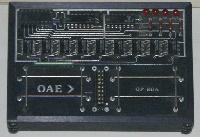 The OP-80A is a very basic paper-tape reader produced by the Oliver Audio
Engineering company in 1976. To read a tape, you have to position a bright
light over the unit, then run the tape through the wire guides and pull it
over the optical sensor. Paper tape was a common form of program storage in
the very early days of personal computing - it stores it's data as a series
of punched holes on a paper strip.
Manual (200k PDF).
The OP-80A is a very basic paper-tape reader produced by the Oliver Audio
Engineering company in 1976. To read a tape, you have to position a bright
light over the unit, then run the tape through the wire guides and pull it
over the optical sensor. Paper tape was a common form of program storage in
the very early days of personal computing - it stores it's data as a series
of punched holes on a paper strip.
Manual (200k PDF).
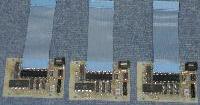 One of the first personal networking systems, these EasyNet boards plug into
the processor socket of most Z80 based CP/M machines - the original CPU moves
to the socket on the card. The software diskette contains a number of replacement
CP/M utilities which take advantage of the network. Donated by Richard Parsons.
One of the first personal networking systems, these EasyNet boards plug into
the processor socket of most Z80 based CP/M machines - the original CPU moves
to the socket on the card. The software diskette contains a number of replacement
CP/M utilities which take advantage of the network. Donated by Richard Parsons.
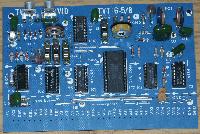 First published in 1978, Don Lancasters "Cheap Video Cookbook" described a way
to generate video with a combination of hardware and software that was extreamly
cost effective. Also available from Synergetics (his company) was the TVT 6-5/8
board kit on which you could build the circuit.
First published in 1978, Don Lancasters "Cheap Video Cookbook" described a way
to generate video with a combination of hardware and software that was extreamly
cost effective. Also available from Synergetics (his company) was the TVT 6-5/8
board kit on which you could build the circuit.
 The Quadram MICROFAZER is a 1983 vintage print buffer. Featuring up to 512k
of memory (a lot for the text printouts used at the time), it would rapidly
download data for the printer so that your (non-multitasking) computer could
continue while the job was printing. Today this function is performed by
software print spoolers. Here is a 1983 Byte Advertisement.
The Quadram MICROFAZER is a 1983 vintage print buffer. Featuring up to 512k
of memory (a lot for the text printouts used at the time), it would rapidly
download data for the printer so that your (non-multitasking) computer could
continue while the job was printing. Today this function is performed by
software print spoolers. Here is a 1983 Byte Advertisement.
 Central Point Software "Option Board". This card provide direct access to
the digital data stream to the floppy disk drive, allowing the PC to read
and write formats not possible on the standard 765 controller. This is the
only way I know of to allow a PC to read/write 800k Macintosh format disks.
It also permits copying of virtually any diskette. Donated by Doug Terry.
Central Point Software "Option Board". This card provide direct access to
the digital data stream to the floppy disk drive, allowing the PC to read
and write formats not possible on the standard 765 controller. This is the
only way I know of to allow a PC to read/write 800k Macintosh format disks.
It also permits copying of virtually any diskette. Donated by Doug Terry.
 TRS-80 Color Computer "Plug 'n Power" X10 Controller. Cartridge contains
a home control software program.
TRS-80 Color Computer "Plug 'n Power" X10 Controller. Cartridge contains
a home control software program.
1987 Tandy/Radio-Shack catalog
page.
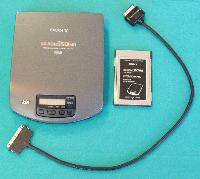 The Sony PRD-150 is a "diskman" portable CD player with a twist. It
has a small connector on the back, and a companion PCMCIA card and
cable that allows you to turn it into a CD-ROM drive. This allows you
to read CD's on any portable computer without a built in CD drive, as
long as it has a PCMCIA socket.
The Sony PRD-150 is a "diskman" portable CD player with a twist. It
has a small connector on the back, and a companion PCMCIA card and
cable that allows you to turn it into a CD-ROM drive. This allows you
to read CD's on any portable computer without a built in CD drive, as
long as it has a PCMCIA socket.
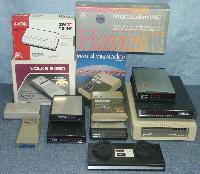 A number of older modems, clockwise from lower left:
A number of older modems, clockwise from lower left:
Volksmodem for C64, Atari XM301, Hayes Smartmodem 1200, US Robotics courier
HST (this was THE modem to have), Gandalf Access 24V, Radio Shack TS-80
acoustic coupler, TEO SmartPRO, Supra 14.4.
Center: Manual Mini-modem, Packard-bell 2400.
 This is a Victory Autoloader. It supports both 5.25" and 3.5" diskette drives (3.5"
hoppers shown), and provides a serial interface that allows your PC to automatically,
load, Accept or Reject diskettes. I put many 1,000's of disks through this machine
when we shipped software on this medium.
This is a Victory Autoloader. It supports both 5.25" and 3.5" diskette drives (3.5"
hoppers shown), and provides a serial interface that allows your PC to automatically,
load, Accept or Reject diskettes. I put many 1,000's of disks through this machine
when we shipped software on this medium.
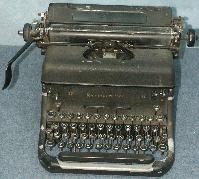 What did we do before computers? Here's a 1940's "manual wordprocessor". The
Remington-Rand Model 17 typewriter.
What did we do before computers? Here's a 1940's "manual wordprocessor". The
Remington-Rand Model 17 typewriter.
For you young whipper-snappers who
don't know what this is - think of it as a keyboard and printer which operates
without electricity. Pressing a key moves a lever
which in turn flicks a hammer with raised letter
to contact the paper through an inked ribbon. A system of levers, gears and
cables moves the carriage and advances the ribbon with each character printed.
Back to Old Computers
Copyright 2004-2005 Dave Dunfield.
 Types of floppy drives - left to right:
Types of floppy drives - left to right:









